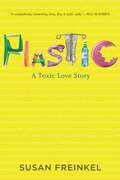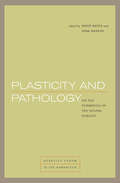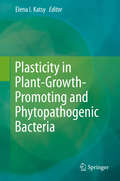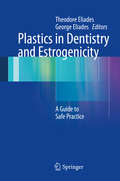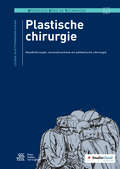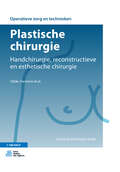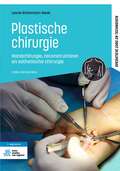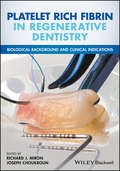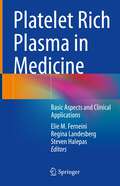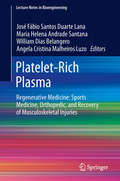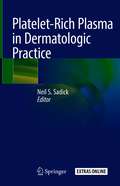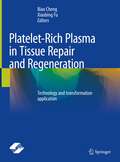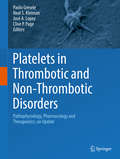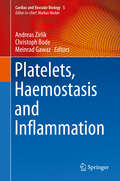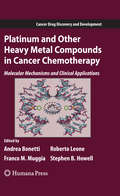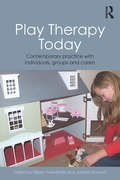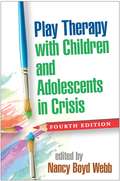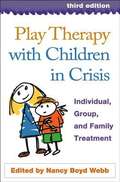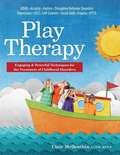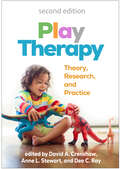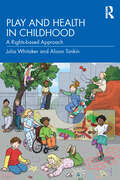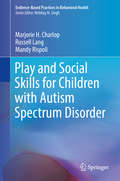- Table View
- List View
Plastic: A Toxic Love Story
by Susan FreinkelPlastic built the modern world. Where would we be without bike helmets, baggies, toothbrushes, and pacemakers? But a century into our love affair with plastic, we’re starting to realize it’s not such a healthy relationship. Plastics draw on dwindling fossil fuels, leach harmful chemicals, litter landscapes, and destroy marine life. As journalist Susan Freinkel points out in this engaging and eye-opening book, we’re nearing a crisis point. We’ve produced as much plastic in the past decade as we did in the entire twentieth century. We’re drowning in the stuff, and we need to start making some hard choices. Freinkel gives us the tools we need with a blend of lively anecdotes and analysis. She combs through scientific studies and economic data, reporting from China and across the United States to assess the real impact of plastic on our lives. She tells her story through eight familiar plastic objects: comb, chair, Frisbee, IV bag, disposable lighter, grocery bag, soda bottle, and credit card. Her conclusion: we cannot stay on our plastic-paved path. And we don’t have to. Plastic points the way toward a new creative partnership with the material we love to hate but can’t seem to live without.
Plasticity and Pathology: On the Formation of the Neural Subject (Berkeley Forum In The Humanities Ser.)
by David Bates Nima BassiriTwo leading neuroscientists examine the current paradigm of the &“neural subject&” and what we can learn from neurological trauma, pathology, and adaption. With the rise of cognitive science and the revolution in neuroscience, the study of human subjects—thinking, feeling, acting individuals—ultimately focuses on the human brain. In both Europe and the United States, massive state-funded research is focused on mapping the brain in all its remarkable complexity. The metaphors employed are largely technological, using a diagram of synaptic connectivity as a path to understanding human behavior. But alongside this technologized discourse, we find another perspective, one that emphasizes the brain&’s essential plasticity, both in development and as a response to traumas such as strokes, tumors, or gunshot wounds. This collection of essays brings together a diverse range of scholars to investigate how the &“neural subject&” of the twenty-first century came to be. Taking approaches both historical and theoretical, they probe the possibilities and limits of neuroscientific understandings of human experience. Topics include landmark studies in the history of neuroscience, the relationship between neural and technological &“pathologies,&” and analyses of contemporary concepts of plasticity and pathology in cognitive neuroscience. Central to the volume is a critical examination of the relationship between pathology and plasticity. Because pathology is often the occasion for neural reorganization and adaptation, it exists not in opposition to the brain&’s &“normal&” operation but instead as something intimately connected to our ways of being and understanding.
Plasticity in Plant-Growth-Promoting and Phytopathogenic Bacteria
by Elena I. KatsyPlasticity in Plant-Growth-Promoting and Phytopathogenic Bacteria brings together the expertise of a panel of researchers from around the world to provide comprehensive up-to-date reviews on the most interesting aspects of genomic and phenotypic plasticity in plant-beneficial and phytopathogenic bacteria. The book covers various topics, including common and specific features in the genomes of symbiotic, plant-growth-promoting, and phytopathogenic bacteria; regulation of conjugative plasmid transfer in rhizobia; genetic and phenotypic variability in plant-beneficial pseudomonads and azospirilla; genomic fluxes in phytopathogenic xanthomonads and pseudomonads; genome plasticity in obligate parasitic Phytoplasmas; comparative genomics of plant-growth-promoting and phytopathogenic Herbaspirillum species; horizontal gene transfer in planta and microevolution of plant-associated bacteria in the phytosphere. Plasticity in Plant-Growth-Promoting and Phytopathogenic Bacteria is recommended for all microbiology and plant biology laboratories.
Plasticity in Sensory Systems
by Jennifer K. E. Steeves Laurence R. HarrisCentered on three themes, this book explores the latest research in plasticity in sensory systems, focusing on visual and auditory systems. It covers a breadth of recent scientific study within the field including research on healthy systems and diseased models of sensory processing. Topics include visual and visuomotor learning, models of how the brain codes visual information, sensory adaptations in vision and hearing as a result of partial or complete visual loss in childhood, plasticity in the adult visual system, and plasticity across the senses, as well as new techniques in vision recovery, rehabilitation, and sensory substitution of other senses when one sense is lost. This unique edited volume, the fruit of an International Conference on Plastic Vision held at York University, Toronto, will provide students and scientists with an overview of the ongoing research related to sensory plasticity and perspectives on the direction of future work in the field.
Plastics in Dentistry and Estrogenicity
by Theodore Eliades George EliadesThis book provides a timely and comprehensive review of our current knowledge of BPA release from dental polymers and the potential endocrinological consequences. After a review of the history and evolution of the issue within the broader biomedical context, the estrogenicity of BPA is explained. The basic chemistry of the polymers used in dentistry is then presented in a simplified and clinically relevant manner. Key chapters in the book carefully evaluate the release of BPA from polycarbonate products and composite resins and the estrogenicity of these materials. Currently available evidence on the potential estrogenic action of dental composities, sealants, and adhesives is presented, and means are suggested by which adverse health effects can be minimized. The entire dental community will find this book to be an excellent source of information on the true risks posed by BPA, and an invaluable aid to safe practice.
Plastische chirurgie
by Leonie Ruettermann-KwakPlastische chirurgie. Handchirurgie, reconstructieve en esthetische chirurgie bestaat uit zes delen die achtereenvolgens de algemene principes en de richtlijnen van dit specialisme en van weefselverplaatsing behandelen. Vervolgens komen operaties aan het hoofd-halsgebied, de romp en de extremiteiten aan bod. Nieuw is het zesde deel: operaties die over het gehele lichaam kunnen voorkomen. Dit betreft operaties in verband met decubitus en brandwonden. De operatiebeschrijvingen worden in dit deel voorafgegaan door een uitgebreide inleiding met informatie over oorzaken, classificatie van de wonden en verschillende opties voor de behandeling. Omdat de wondzorg een essentieel onderdeel is van de plastische, reconstructieve en handchirurgie, is het boek uitgebreid met een overzicht van verschillende wondverbanden en hun kenmerken.Dit boek is in eerste instantie geschreven als leerboek voor operatieassistenten, maar kan ook als naslagwerk door andere beroepsgroepen in de gezondheidszorg worden gebruikt. De reeks 'Operatieve Zorg en Technieken' is bestemd voor de opleiding tot operatieassistent. Naast het basisboek bestaat de reeks uit een aantal vervolgdelen, waarin de verschillende subspecialismen van de chirurgie worden behandeld.Elk deel heeft dezelfde indeling. Ieder hoofdstuk begint met een inleiding, gevolgd door een uitwerking van de pre-, per- en postoperatieve fase van een operatie. Bij alle operatiebeschrijvingen staat een vermelding van de operatie-indicatie en het doel van de operatie. Achter in het boek wordt altijd een selectie opgenomen van veelvoorkomend specifiek instrumentarium.
Plastische chirurgie: Handchirurgie, reconstructieve en esthetische chirurgie (Operatieve zorg en technieken)
by Leonie Ruettermann-KwakDit leerboek biedt inzicht in de theoretische en praktische aspecten van plastisch chirurgische operaties. Daarnaast wordt, indien van toepassing, uitgelegd hoe een bepaalde operatie onderdeel uitmaakt van een geheel behandelplan, zoals een schisis- of genderoperatie.Dit boek bestaat uit zes delen die achtereenvolgens de algemene principes en de richtlijnen van dit specialisme en van weefselverplaatsing behandelen. Vervolgens komen operaties aan het hoofd-halsgebied, de romp en de extremiteiten aan bod. Daarnaast wordt er aandacht besteed aan operaties die op het gehele lichaam kunnen voorkomen, namelijk brandwonden en decubitus. Omdat goede wondzorg essentieel is in plastische chirurgie, biedt dit boek een overzicht van relevante wondverbanden en hun kenmerken.Nieuw in deze vijfde druk zijn de beschrijvingen van twee operaties aan de hand/pols.De reeks ‘Operatieve Zorg & Technieken’ is bestemd voor de opleiding tot operatieassistent. Naast het basisboek bestaat de reeks uit een aantal vervolgdelen, waarin de verschillende chirurgische specialismen worden behandeld. Deze reeks benadert de beroepsuitoefening van de operatieassistent zo dicht mogelijk, waarbij de gebruikte illustraties en afbeeldingen deze benadering ondersteunen.
Plastische chirurgie: Handchirurgie, reconstructieve en esthetische chirurgie (Operatieve zorg en technieken)
by Leonie Rüttermann-KwakDit leerboek biedt inzicht in de theoretische en praktische aspecten van plastisch chirurgische operaties. Daarnaast wordt, indien van toepassing, uitgelegd hoe een bepaalde operatie onderdeel uitmaakt van een geheel behandelplan, zoals een schisis- of genderoperatie. Dit boek bestaat uit zes delen die achtereenvolgens de algemene principes en de richtlijnen van dit specialisme en van weefselverplaatsing behandelen. Vervolgens komen operaties aan het hoofd-halsgebied, de romp en extremiteiten aan bod. Daarnaast wordt er aandacht besteed aan operaties die op het gehele lichaam kunnen voorkomen, namelijk decubitus. Omdat goede wondzorg een essentieel onderdeel is in de plastische chirurgie, biedt dit boek een overzicht van de relevante wondverbanden en hun kenmerken. Nieuw in deze zesde druk zijn de beschrijvingen van de voorhoofd- en wenkbrauwlift en de endoscopische decompressie van de nervus ulnaris. Daarnaast is de transplantatie van de fibula naar de mandibula beschreven. De reeks ‘Operatieve Zorg en Technieken´ is bestemd voor de opleiding tot operatieassistent. Naast het basisboek bestaat de reeks uit een aantal vervolgdelen, waarin de verschillende chirurgische specialismen worden behandeld. Deze reeks benadert de beroepsuitoefening van de operatieassistent zo dicht mogelijk, waarbij de gebruikte illustraties en afbeeldingen deze benadering ondersteunen.
Platelet Rich Fibrin in Regenerative Dentistry: Biological Background and Clinical Indications
by Richard J. Miron Joseph ChoukrounThe first book devoted exclusively to the subject, Platelet Rich Fibrin in Regenerative Dentistry offers comprehensive, evidence-based coverage of the biological basis and clinical applications of PRF in dentistry. Co-edited by a leading researcher in tissue regeneration and the inventor of the PRF technique, it brings together original contributions from expert international researchers and clinicians. Chapters cover the biological foundation of PRF before addressing specific uses of the technology within clinical dentistry. Topics describe the use of PRF in many dental applications, including extraction socket management, sinus lifting procedures, root coverage, periodontal regeneration, soft tissue healing around implants, guided bone regeneration, and facial esthetics. The text is supplemented with color photographs and explanatory illustrations throughout. Platelet Rich Fibrin in Regenerative Dentistry: Biological Background and Clinical Indications is an indispensable professional resource for periodontists, oral surgeons and oral and maxillofacial surgeons, as well as general dentists who use PRF or are interested in introducing it into their practices. It is also an excellent reference for undergraduate and postgraduate dental students.
Platelet Rich Plasma in Medicine: Basic Aspects and Clinical Applications
by Elie M. Ferneini Steven Halepas Regina LandesbergThis book offers a comprehensive overview of the use of platelet rich plasma (PRP), typically by injection, and its usage across medical disciplines. This multi-authored, multi-institutional, and multi-specialty based text is designed to guide health care providers in the varied uses of PRP -- starting from its history and preparation and moving through a variety of disciplines to illustrate how PRP can help healing. Clinical Applications of Platelet Rich Plasma in Medicine is divided into three sections: The first gives an overview of the basic science of PRP; the second provides a detailed overview of the clinical indications of PRP; and the third section discusses potential complications in conjunction with relevant case studies. It will feature a wealth of images and diagrams to illustrate best practices in using PRP.Written to be used by oral and maxillofacial surgeons, plastic surgeons, cosmetic surgeons, otolaryngologists, dentists, orthopedic surgeons, and general surgeons to name a few, this book will provide an evidence-based approach to using PRP in practice. The editors have extensive academic experience and have authored multiple scientific publications, while the contributions included in the text have been written by experts and leaders in the fields touched upon in the book.
Platelet Rich Plasma in Musculoskeletal Practice
by Nicola MaffulliThis book provides an introductory overview of advancements in platelet-rich plasma (PRP), focusing on current technologies and methods, new challenges and controversies, and avenues for further research. With many studies demonstrating a role for PRP in improving response to injury, this book aims to facilitate the application of this rapidly growing treatment option for trauma patients. Platelet Rich Plasma in Musculoskeletal Practice is a highly informative and carefully presented book, providing scientific and clinical insight for specialists who utilize PRP in daily practice, and for readers who are seeking to learn more about this effective injury treatment.
Platelet-Rich Plasma
by José Fábio Santos Duarte Lana Maria Helena Andrade Santana William Dias Belangero Angela Cristina Malheiros LuzoPlatelet-Rich Plasma (PRP) has gained tremendous popularity in recent years as a treatment option for specialties including Orthopedics, Dentistry, Sports Medicine, Otorhinolaryngology, Neurosurgery, Ophthalmology, Urology, Vascular, Cardiothoracic and Maxillofacial Surgery, and Veterinarian Medicine. Nowadays, PRP and Stem Cell Science have added an exciting dimension to tissue repair. This book begins by giving the reader a broad overview of current progress as well as a discussion of the technical aspects of preparation and therapeutic use of autologous PRP. It is followed by a review of platelet structure, function and major growth factors in PRP (PDGF and TGFβ). The third chapter outlines the basic principles of biochemical cellular metabolism that increases the efficacy of PRP. Analogous to the preparation of soil for a garden, restoring cellular health should be the first consideration in Regenerative Medicine. Standardization of PRP preparation to clinical use still remains a challenging prospect. In this sense, a feasible strategy for studying PRP preparation is illustrated, which also allows to modulate and tailor the quality of PRP for further clinical applications. The science behind PRP and stem cells, on tissue regeneration, cell proliferation and mesenchyme stem-cells are emphasized and reviewed. Various specific uses of PRP are described with detailed illustrations of various personal experiences mainly in orthopedic injuries, ligament and tend on repair, degenerative diseases, sports medicine, chronic wound healing as well as rehabilitation aspects in tendinopathy. Expertly written by leading scientists in the field, this book provides for beginners and experienced readers scientific fundamentals, the state of art of PRP, specific uses and personal experiences with a practical approach and reference for current trends in use. Finally, this book paves the way for future developments.
Platelet-Rich Plasma in Dermatologic Practice
by Neil S. SadickThis book details the uses of platelet-rich plasma (PRP) techniques for dermatologic purposes and describes the techniques and protocols for its application in clinical practice. Concise and practical, this reference covers not only the procedural steps in collecting PRP from a patient, but also applications in wound healing, hair loss, skin rejuvenation, scarring, and face and body augmentation. It addresses the issues that are caused by fad procedures, such as the "Vampire Facelift," and emphasizes the importance of reliable information in these cases. Chapters are supplemented with multimedia including high-quality images, illustrations, and an instructional video. Platelet-Rich Plasma in Dermatologic Practice is written for clinicians in practice looking to offer alternatives to more invasive aesthetic surgery techniques.
Platelet-Rich Plasma in Tissue Repair and Regeneration: Technology and transformation application
by Xiaobing Fu Biao ChengFrom clinical application to experimental research, this book summarizes the transformation value of Platelet-Rich Plasma, explores its potential research hotspots, and ultimately serves the clinic. On the one hand, the main content of this work is to explain the research progress of Platelet-Rich Plasma in the laboratory, including the mechanisms involved in its research and possible potential therapeutic effects. On the other hand, this work aims to clarify its application foundation and value in Aesthetic Surgery. The purpose is to provide reliable reference tools for relevant work practitioners, build a bridge between experimental research and clinical application, and promote the progress of Platelet-Rich Plasma-related translational medicine.
Platelets in Thrombotic and Non-Thrombotic Disorders
by Clive P. Page Paolo Gresele Neal S. Kleiman José A. LopezPlatelets have become an important research target for clinicians and basic scientists in a range of medical disciplines. This book reviews current science and applications in fields including thrombosis and hemostasis, signal transduction, and non-thrombotic conditions such as inflammation, allergy and tumor metastasis. It is a detailed, up-to-date, highly referenced text for clinical scientists and physicians, including recent developments in this rapidly expanding field. More than a scientific resource, this is also an authoritative reference and guide to the diagnosis and therapeutics of diseases involving platelets. Chapters are devised to provide a critical review of the most clinically relevant aspects of the subject. It will be an essential reference for biomedical scientists and clinicians in hematology, vascular medicine, cardiology, thrombosis and related disciplines.
Platelets, Haemostasis and Inflammation (Cardiac and Vascular Biology #5)
by Andreas Zirlik Christoph Bode Meinrad GawazThe book depicts the various roles of platelets in a variety of cardio-metabolic diseases. Traditional and non-traditional platelet functions are described in detail in atherosclerosis, metabolic syndrome, diabetes, myocardial infarction, and other vascular pathologies. Particular focus is put on platelets as a link between haemostasis and inflammation contributing to both. Last but not least the books links the most recent advances in basic sciences with promising novel therapeutic applications and first results of clinical trials. The book is written for biomedical scientists in the sub disciplines vascular biology, biochemistry and immunology; and it as well will be of interest and value for academic physicians like cardiologists, hematologists, general internists and vascular surgeons.
Platinum and Other Heavy Metal Compounds in Cancer Chemotherapy
by Franco Muggia Andrea Bonetti Stephen B. Howell Roberto LeoneThe platinum-containing chemotherapeutic agents remain key components of many of the most effective regimens for the treatment of cancer. New information about the chemistry, pharmacology and molecular mechanisms by which these drugs work is leading to both the development of new drugs and more effective use of existing members of this class. Better definition of the genetic basis of malignancies is offering intriguing new insights in to how to use these drugs in a more individualized manner. "Platinum and Other Heavy Metal Compounds in Cancer Chemotherapy: Molecular Mechanisms and Clinical Applications", edited by Andrea Bonetti, Steve B. Howell, Roberto Leone, and Franco Muggia, provides succinct summaries of the major new developments in field of platinum drug therapy drawn from presentations made at the 10th International Symposium on Platinum Coordination Compounds in Cancer Chemotherapy that took place in Verona, Italy, in December 2007. This meeting, held once every 4 years, brought together the world's leading investigators working on platinum drugs and their contributions provide a detailed survey of the major research directions in this rapidly evolving field.
Play Therapy Interventions to Enhance Resilience
by Robert Brooks Sam Goldstein David A. CrenshawThe importance of therapeutic play in helping children recover from adversity has long been recognized. This unique volume brings together experts on resilience, trauma, and play therapy to describe effective treatment approaches in this key area. The book begins by providing guiding principles for intervention and describing the specific properties of play that promote resilience. Subsequent chapters delve into clinical applications, including such strategies as storytelling and metaphors, sand play, art therapy, play therapy adaptations for school settings, group interventions, and the use of therapeutic writing. Rich case studies and vignettes demonstrate creative ways to bolster at-risk children's strengths and enhance their natural capacity to thrive.
Play Therapy Today: Contemporary Practice with Individuals, Groups and Carers
by Justine Howard Eileen PrendivillePlay Therapy Today brings together the work of renowned practitioners and academics currently working and researching in therapeutic play and play therapy, and presents a range of ground-breaking methods for practising with groups, individuals, and parents and carers. Providing an overview of new or revitalised topics in play therapy, each chapter presents the relevant theoretical underpinnings and principles of practice, a guide to implementing the method and case study vignettes of the approach in practice. The three sections include chapters on: the Therapeutic Touchstone model and the development of the therapeutic relationship, an overview of the use of individual play therapy techniques with children in a hospital setting, and an overview of Yasenik and Gardner’s Play Therapy Dimensions Model with an in-depth exploration of the dimension of consciousness from both a theoretical and practical, play-based orientation. Jennings’ Embodiment-Project-Role model and its implementation in group work, the practical use of puppets in educational and therapeutic settings, the therapeutic value of working with groups in the outdoors, and the use of play in groups for children with a variety of sensory, intellectual and physical disabilities. Stagnitti’s adaptation of the ‘Learn to Play’ programme for parent/carer use, Group Theraplay with peer groups and parent/child dyads and how a neurosequential approach supports case conceptualization and play therapy practice with families. The book provides practitioners with up-to-date, effective and practical techniques that they can put into immediate use in their clinical work with children and their families. It is an important resource for trainee, newly qualified and seasoned play therapists, play therapy supervisors and trainers. It will also be of interest to social workers, teachers, psychologists, child psychotherapists and other health professionals.
Play Therapy with Children and Adolescents in Crisis, Fourth Edition
by Nancy Boyd Webb MD Lenore C. TerrThis widely used practitioner resource and course text is considered the most comprehensive guide to working with children who have experienced major losses, family upheavals, violence in the school or community, and other traumatic events. Leading experts present a range of play and creative arts therapy techniques in chapters organized around in-depth case examples. Informed by the latest knowledge on crisis intervention and trauma, the book now encompasses work with adolescents as well as younger children. Each chapter concludes with instructive questions for study or reflection. New to This Edition *Expanded age range: now includes expressive therapy approaches for adolescents. *More attention to traumatic stress reactions and posttraumatic stress disorder (PTSD); several chapters address complex trauma. *Extensively revised with the latest theory, practices, and research; many new authors. *Additional topics: parental substance abuse, group work with adolescents, chronic medical conditions, animal-assisted play therapy and courtroom testimony, and more.
Play Therapy with Children in Crisis, Third Edition
by Nancy WebbHEOA Compliance Copy July 2011This practical casebook and widely adopted text presents effective, creative approaches to helping children who have experienced such stressful situations as parental death or divorce, abuse and neglect, violence in the school or community, and natural disasters. New to This Edition Incorporates advances in knowledge on crisis intervention, trauma, and short-term play therapy. 17 of the 21 chapters are entirely new. Additional topics parental military deployment, the impact of Hurricane Katrina on families, immigration-related trauma, terrorism, and disrupted adoption.
Play Therapy: Engaging & Powerful Techniques For The Treatment Of Childhood Disorders
by Clair MellenthinDiscover why play therapy works and how to use it to treat childhood mental health challenges such as: ADHD Anxiety Autism Disruptive Behavior Disorders Depression OCD PTSD Trauma Self-Esteem Social Skills Play Therapy is filled with dozens of powerful play techniques adapted for use in individual, family, and group therapy, for schools, and at home. Inside you ll find: Hands on Activities Printable Worksheets Expressive and Creative Arts Dynamic Therapeutic Games Puppet Play Guided Imagery Parent-Child Interventions Tips for Parents & Teachers.
Play Therapy: Theory, Research, and Practice
by David A. Crenshaw Anne L. Stewart Dee C. RayNow in a significantly revised second edition featuring 85% new material, this authoritative play therapy reference and text comprehensively reviews the current state of the field. Expert contributors describe theoretical foundations, showcase widely used clinical approaches, and explore challenging and timely professional issues. The book presents vivid case illustrations and synthesizes the play therapy research base. Chapters on specific populations (such as neurodivergent children, culturally diverse children, adolescents) and clinical problems (such as trauma, disrupted attachment, anxiety) provide engaging course content and the knowledge therapists need to tailor interventions effectively. New to This Edition *Chapters on Gestalt play therapy, prescriptive play therapy, group play therapy, and nature-based play therapy. *Chapters on racial trauma, chronic illness, depression and suicidality, and attachment trauma. *Chapters on working with infants and parents, immigrant children and families, and LGBTQIA+ youth. *Chapters on telemental health, resilience, parent consultation, and working within child protection and legal systems. *Enhanced focus on research, with new coeditor Dee C. Ray bringing particular expertise.
Play and Health in Childhood: A Rights-based Approach
by Alison Tonkin Julia WhitakerTaking a rights-based approach to the interdependence of play and health in childhood, this text argues that the child’s right to health and development cannot be satisfied without also the fulfillment of their right to play. Underpinned by theory and real-life ‘case stories’ drawn from practice and family life, Whitaker and Tonkin present what is known about the benefits of play and its potential to address the pressing health needs in the short and long terms of the youngest generation. They define and discuss the concepts of childhood, play, health, and human rights before exploring how play interacts with the four fundamental principles of the UN Convention on the Rights of the Child: non-discrimination; best interests; life, survival, and development; and inclusion and participation. The book then investigates how practitioners can advocate for the child’s right to play to meet all their health and development needs. It presents numerous examples of best practice from a range of settings – including hospitals, schools, community initiatives, charities, families, and more – and incorporates the voices of children as they imagine a future in which play is elevated to a central position in their lives, allowing for the achievement of lifelong health and happiness. Exploring children’s rights from a practical perspective, this accessible book is essential reading for students and practitioners in healthcare, social work, community work, early years, and education.
Play and Social Skills for Children with Autism Spectrum Disorder (Evidence-based Practices In Behavioral Health Ser.)
by Russell Lang Marjorie H. Charlop Mandy RispoliThis book discusses the deficits in the development and presentation of play behavior and social skills that are considered central characteristics of autism spectrum disorder (ASD). The book explains why play provides an important context for social interactions and how its absence can further exacerbate social deficits over time. It highlights the critical roles of social skills in development, and the social, cognitive, communication, and motor components of play. Chapters offer conceptually and empirically sound play and social skills interventions for children with ASD. Play activities using diverse materials and including interactions with peers and parents are designed to promote positive, effective social behaviors and encourage continued development. The book provides unique strategies that can be tailored to fit individual children’s strengths and deficits.Topics featured in this book include:Naturalistic Teaching Strategies (NaTS) for developing play and social skills. Teaching play and social skills with video modeling. Peer-mediated intervention (PMI) strategies that promote positive social interactions between children with ASD and their peers. Visual Activity Schedules and Scripts. Parent-implemented play and social skills intervention.Play and Social Skills for Children with Autism Spectrum Disorder is a must-have resource for researchers, clinicians, and graduate students in clinical child and school psychology, behavioral therapy/rehabilitation, social work, public health, and related psychology, education, and behavioral health fields.
